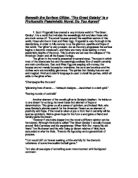“In The Great Gatsby, Fitzgerald portrays a society in which wealth, love and social status are inextricably linked.” Do you agree?
Scott Fitzgerald’s novel The Great Gatsby is set in post-war America and portrays a multitude of important themes surrounding the American Dream, which is personified by Gatsby himself. The novel investigates the validity of the American Dream “in the pursuit of happiness” (1). Fitzgerald creates a world in which society places an immeasurable importance on social status and wealth and attempts to undermine “the implicit separation of love and money” (2). At first it appears that the plot surrounds the disenchanted love between a man and a woman, however, the journey of the novel follows an extremely vast and less romantic distance. Fitzgerald presents his readers with a world in which love and social hierarchy are in huge conflict with each other and his intentions are to show that nothing was able to triumph over the materialism which dominated and moulded the values of a 1920’s American Society. This conflict is explored throughout the novel using the relationships between not only Gatsby and Daisy, but also the love triangle between Tom, Daisy and Myrtle, of which the two female characters are from extremely different social backgrounds.
Jay Gatsby has a dream of romantic idealism which defines his character. Inextricably linked to his love for Daisy is his “quest”, a world that suggests his idealism, for social self-improvement. The love that drives his dream blossomed from his introduction to Daisy many years previously when Gatsby was poor and had no place in society. Gatsby’s goal then becomes his pursuit of Daisy, making money and building himself a new life, trying to create a world that would be perfect in her eyes. This in itself shows the materialism that consumes Daisy’s character, Gatsby knowing that she merely values things that she can see and touch. One thing that Gatsby is unable to build for himself is the ‘old’ American Family name that would give him a firm and high placing in the social hierarchy of East-Egg, Long Island. Fitzgerald presents his readers with a situation with a world in which love can survive or be demoralized according to a character’s position in the hierarchal system, when the ages of money is all-important. Fitzgerald, having lived on Long Island at one point in his life, would have had a great awareness of the gap between his society and that of the ‘old’ society, families such as the Guggenheims, who lived on the other side of the peninsular, owned grand houses and lived lavish lifestyles. This theme is also explored in A Streetcar Named Desire a play that was written over the same time period as Fitzgerald’s novel. It is clear from reading both texts that there was uneasiness between the ‘old’ and the ‘new’, the ‘Dubois’ and the ‘Kowalski’s’ and that the ‘new money’ making its mark in the social circles, were looked upon as unworthy by the ‘old money’. In The Great Gatsby, the society of West Egg represent the ‘new’ as Stanley Kowalski does in A Streetcar Named Desire. The Inhabitants of West Egg are symbolic of the rebels who started to break away from old restrictions that society placed on them in the 1920’s. On the other hand, East Egg’s inhabitants uphold the moral and social laws of formality, at least superficially. Working in conflict with these two ideas are Gatsby’s parties which illustrate the materialism of West Egg’s society and the ‘vacuous laughter’ of the guests at these parties shows their artificial nature and illustrate the extravagant materialism of West Egg. There are very few, if any, moral differences that can be identified to set these two societies apart, yet the community of East Egg has a concrete respectability that is not present in Gatsby’s world. The superficiality of the society is shown through the guest’s “vacuous laughter” an the carelessness displayed in the car crash display a violent and damaging element to their way of life. Fitzgerald uses the symbolic image of the “moth” to illustrate the parasitical self-destructive character of the West Egg society. The hypocrisy of the society of East Egg is shown through Tom’s comment “nowadays people begin by sneering at family life and institutions”, despite his adulterous activities, he feels that he can take the moral high ground because of his social status. Neither love or money are able to surpass the social prejudices because of this snobbery and Gatsby tragically refuses to accept this.








